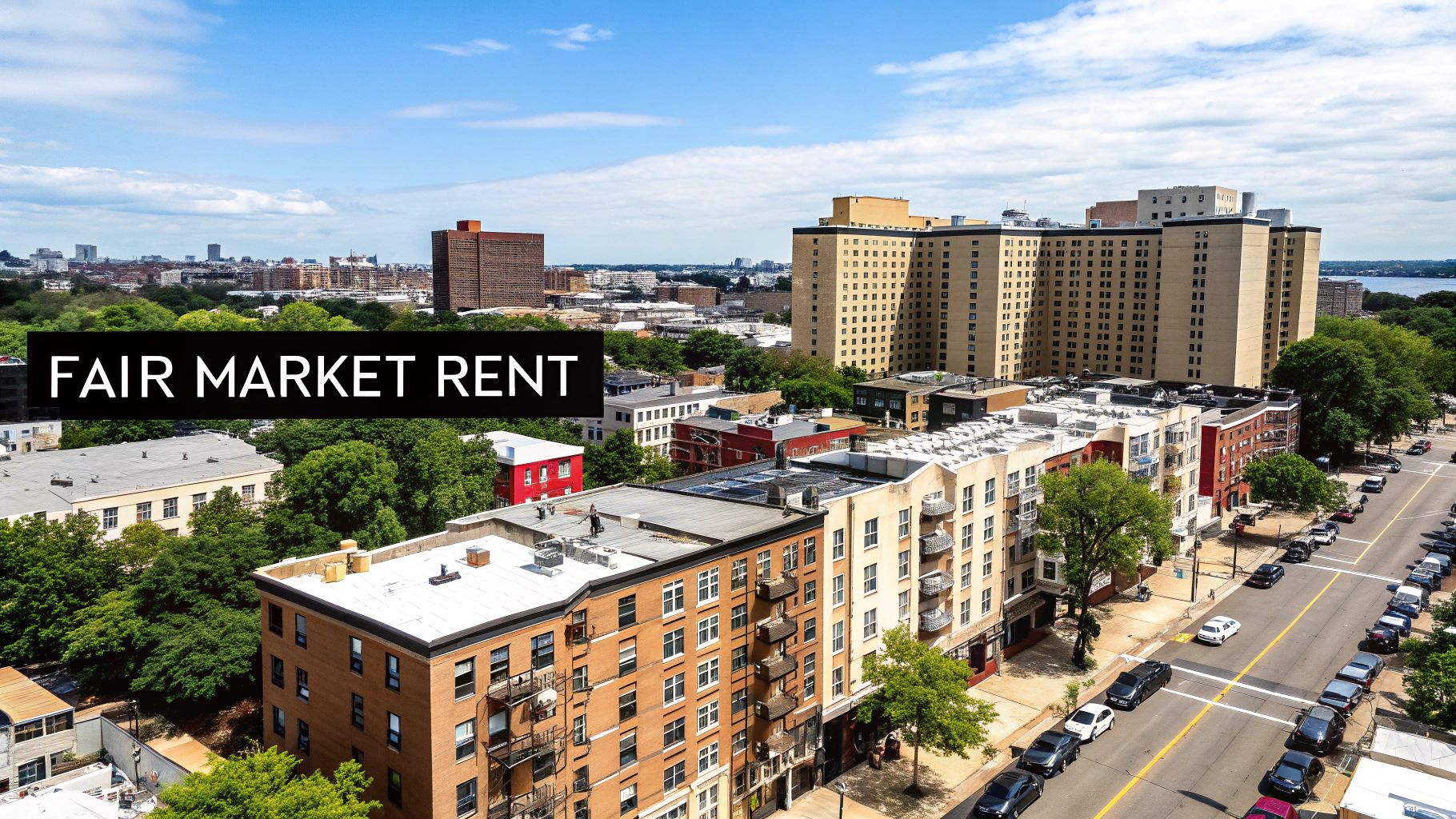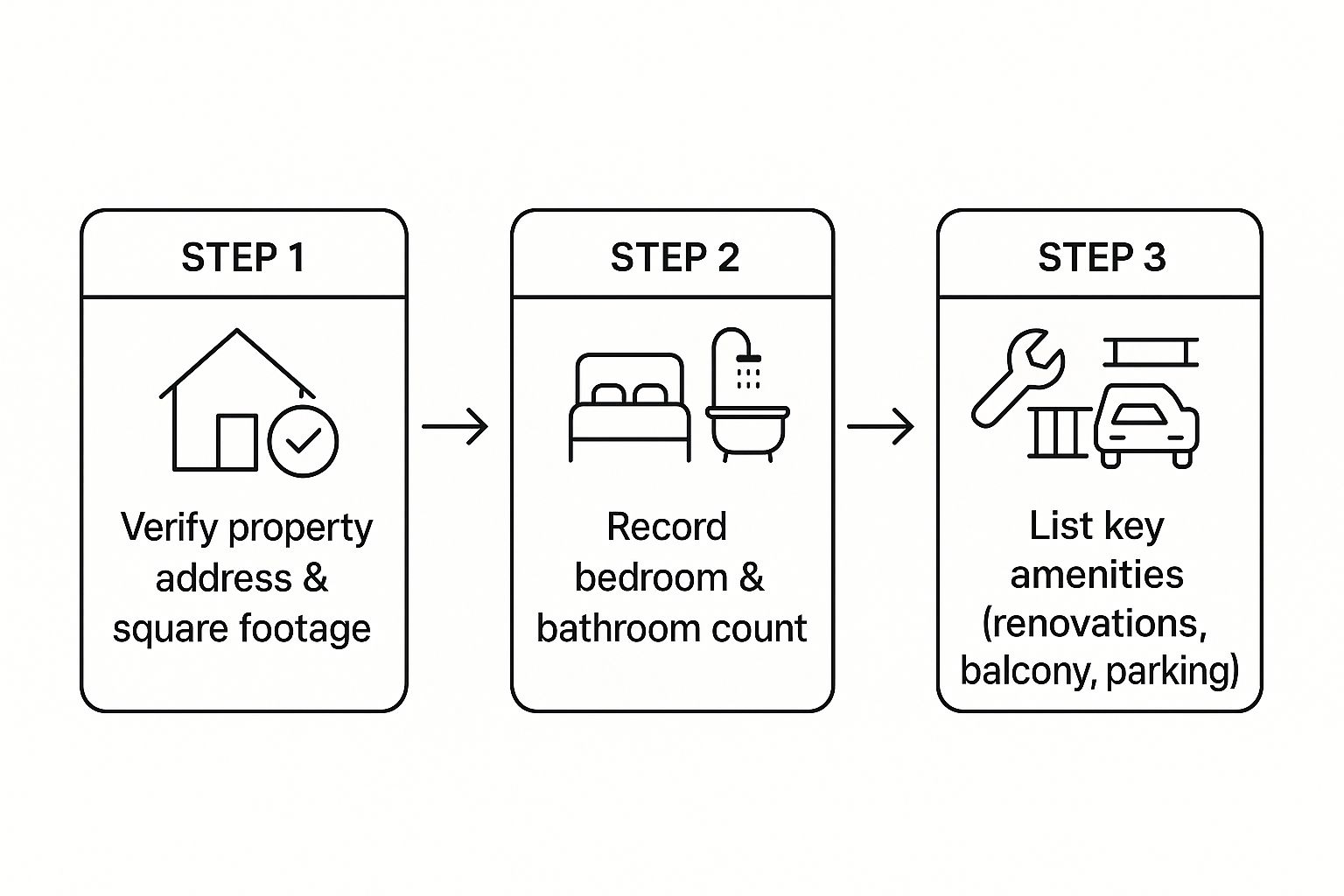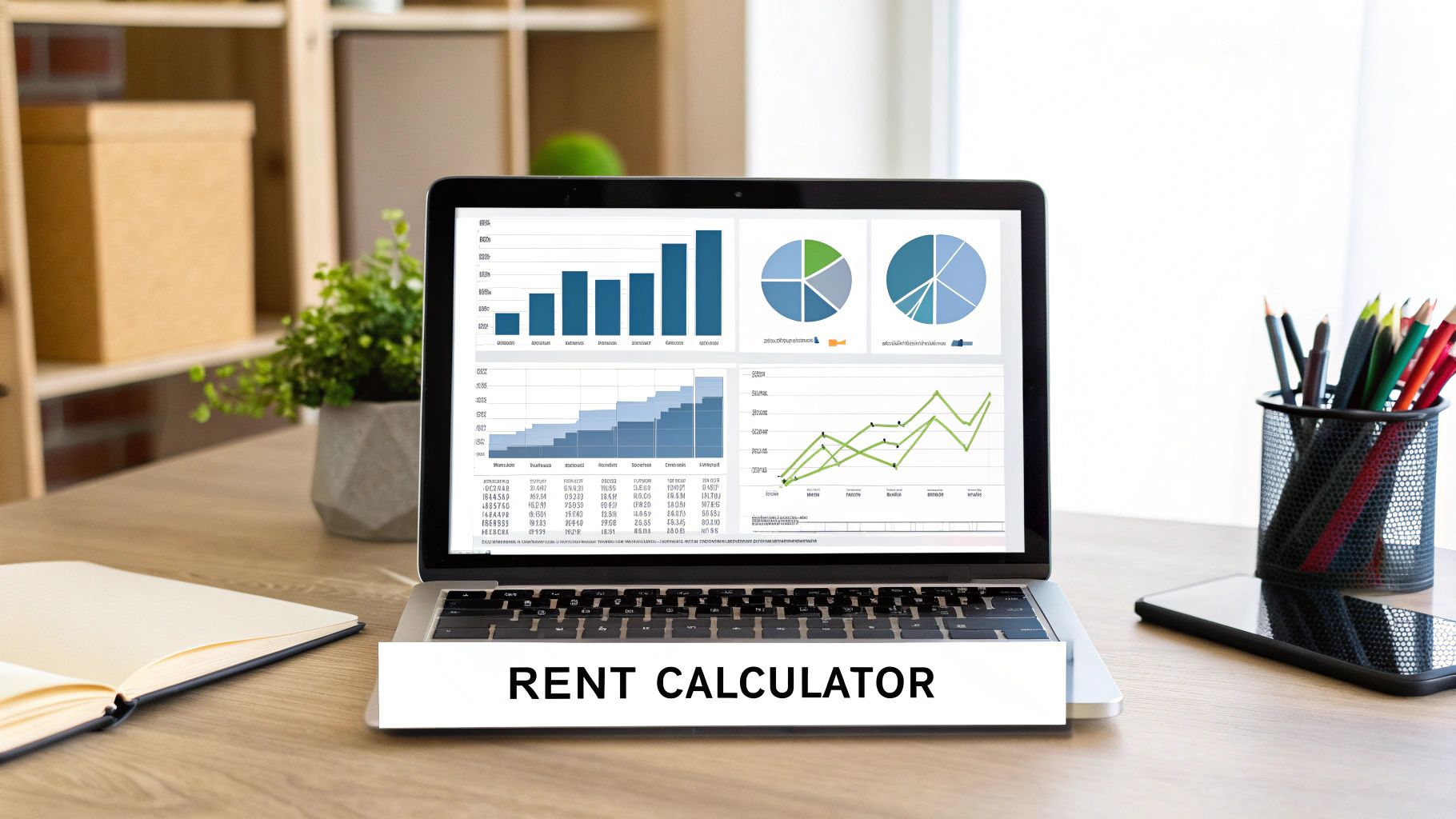Fair Market Rent Calculator Your Pricing Guide
- Sarah Porter
- 2 days ago
- 10 min read
Updated: 2 minutes ago
A fair market rent calculator is essentially a tool that gives you a solid estimate of what a property should rent for in a specific area. It's a crucial data point for both landlords and tenants—it helps owners set the right price and renters know if they're getting a fair deal.
At its core, it’s about aligning your rent with what the local market can actually bear.
What Is Fair Market Rent and Why Should You Care?

When we talk about Fair Market Rent (FMR), we're not just pulling a number out of thin air. It’s a carefully calculated benchmark that reflects the reality of a local rental market. Think of it as the "sweet spot" for pricing your rental property.
For landlords, this isn't just a helpful metric; it's fundamental to running a profitable business. If you set your rent too high, you're looking at long, costly vacancies. Set it too low, and you're leaving cash on the table each month, which eats directly into your returns.
HUD's Role in Defining FMR
In the U.S., Fair Market Rents are officially set by the Department of Housing and Urban Development (HUD) each year. These figures are primarily used for federal housing programs, like Section 8 vouchers, to determine how much assistance a family can receive.
HUD's methodology is pretty specific. They aim to find the 40th percentile rent, meaning the price point that's just below what 40% of standard rental units in that market are leased for. This data comes from comprehensive surveys and gives you a reliable, government-backed baseline to work from. You can dig into the specifics in the official HUD documentation on FMRs.
Even if you're not dealing with housing assistance programs, this data is incredibly valuable. It takes a lot of the guesswork out of pricing your property.
How FMR Affects Your Bottom Line
Getting a handle on the FMR for your area helps you make smarter decisions that directly impact your investment's health. It lets you:
Set a Competitive Rent: Pricing your unit fairly from the start helps you attract a larger pool of qualified tenants and fill vacancies fast.
Justify Rent Increases: When you need to raise the rent on a renewing lease, you can point to FMR data to show your new price is in line with the market, not just an arbitrary hike.
Maximize Profitability: A well-priced unit means less downtime and a more consistent income stream. This is the foundation for understanding what cash flow in real estate is and how it works.
Getting Your Property Details in Order for an Accurate Estimate
Any good rent estimate is only as good as the data you feed it. Before you even think about plugging numbers into a fair market rent calculator, you need to have a crystal-clear picture of your property. I always think of this as building a case for your rental price—and you need solid evidence.
First, lock down the absolute essentials. This means the exact property address, the precise number of bedrooms and bathrooms, and the total square footage. It sounds simple, but you'd be surprised how often a typo can skew the results by putting your property in a slightly different area or misstating its size. Double-check everything.
Think Beyond the Basics: What Amenities Drive Value?
With the core stats nailed down, it’s time to dig into the details that make a renter choose your property over the one down the street. These are the features that justify a premium and really move the needle on your rental income.
Take stock of the little things that add up to big value:
Modern Touches: Have you recently updated the kitchen with new appliances or renovated a bathroom? Those are huge selling points.
A Place to Unwind: A private balcony, a small patio, or a fenced-in yard can be a deal-maker for many tenants.
Convenience is King: Don't forget about dedicated garage spots, covered parking, or that extra storage unit.
In-Unit Perks: Things like a washer and dryer, central AC, or even a dishwasher are practically expected these days and their absence can lower your property's appeal.
Try this: Walk through your property as if you were a prospective tenant. What features would genuinely impress you? Pinpointing these specific, desirable amenities is the secret to getting a rent estimate that truly reflects your property's potential.
This quick visual breaks down exactly what you need to gather.

As you can see, it’s about layering the information—starting with the fundamentals and then adding the specific features that make your property unique. Spending a few extra minutes on this step now will prevent you from relying on a flawed, inaccurate rent estimate down the road.
Getting the Most Out of a Fair Market Rent Calculator

Now that you've gathered all your property details, it’s time to plug them into a fair market rent calculator. These tools are incredibly useful, but remember the old saying: garbage in, garbage out. The accuracy of your estimate hinges entirely on the quality of the data you provide.
Let's say you own a two-bedroom, two-bathroom condo in a popular downtown neighborhood. You'll start with the obvious: the full address, the bed and bath count (2 beds, 2 baths), and the precise square footage (let's use 1,150 sq. ft.). Where you can really dial in the accuracy is by adding those unique features and amenities you listed earlier. This is what separates a generic estimate from a truly reliable one.
Look Beyond the Final Number
Once you hit "calculate," the tool will spit out a result. It's tempting to just grab that single number and run with it, but that's a rookie mistake. The real gold is in the details surrounding that figure.
A quality calculator will give you a rental range, maybe something like $2,150 to $2,400 per month. This range is your sweet spot. Your condo, with its brand-new kitchen and that coveted dedicated parking spot, should command a price at the top of that spectrum. An older, less updated unit down the street? It'll naturally fall closer to the bottom.
The calculator should also show you the "comps"—the comparable properties it used to generate the estimate. Take a few minutes to review these. Are they truly similar to your property in terms of location, condition, and size? This sanity check is crucial for confirming the estimate is grounded in reality.
Pro Tip: Think of the calculator's final number as a strong starting point, not the final destination. Use the entire data set—the rent range and the comps—to strategically position your property and set a price that's both competitive and profitable.
How Property Features Impact Fair Market Rent Estimates
It’s always fascinating to see how much specific amenities can move the needle on rental value. That second full bathroom or an in-unit washer and dryer aren't just conveniences; they are tangible assets that directly translate to higher rent.
To give you a clearer picture, let's look at how a few upgrades could affect the FMR for our hypothetical 2-bedroom apartment.
Property Feature | Baseline Apartment (No Feature) | Apartment with Feature | Estimated Rent Impact |
|---|---|---|---|
Parking | Street Parking Only | Dedicated Garage Spot | +$100 to $150/month |
Laundry | Shared Laundry Room | In-Unit Washer/Dryer | +$75 to $125/month |
Kitchen | Standard Appliances | Renovated with New Appliances | +$50 to $100/month |
Outdoor Space | None | Private Balcony | +$50 to $75/month |
This kind of breakdown doesn't just help you justify your asking price to potential tenants; it also helps you calculate the ROI on future renovations.
Understanding your potential income is only half the battle, of course. You also need to account for your expenses, which you can dig into with a property management cost calculator for rental owners. By pairing these tools, you're no longer just guessing at numbers—you're making informed, data-driven decisions to maximize your investment.
Moving Beyond the Calculator to Analyze Local Trends

A fair market rent calculator gives you a solid number to start with, but it's just that—a start. Think of it as your baseline. The real magic in setting the perfect rent comes from mixing that hard data with a little old-fashioned, on-the-ground detective work in your specific neighborhood.
Your next move is to put on your detective hat. Hop onto popular listing sites like Zillow or Apartments.com and see what you're up against. Be ruthless with your filters—you're looking for true apples-to-apples comparisons. That means the same number of bedrooms, similar square footage, and, most importantly, in the same little pocket of town. This is your direct competition, right now.
Ground-Truthing Your Estimate
As you browse, pay close attention to how long similar units have been sitting vacant. If a condo down the street has been on the market for 60 days, that’s a big red flag; the owner is asking for more than tenants are willing to pay. On the flip side, if properties are getting snapped up in less than a week, you've hit a pocket of high demand. That’s a good sign you might be able to price your place at the higher end of its calculated range.
A calculator is smart, but it can’t see everything. It doesn't know about the new tech campus that just opened down the road or the trendy restaurant district that's suddenly drawing crowds. These are the kinds of local dynamics you need to factor in:
Seasonal Shifts: Are you listing in the dead of winter when nobody wants to move, or is it late spring when the rental market is on fire?
Neighborhood Buzz: That new coffee shop, park, or grocery store can genuinely boost rental demand and justify a higher price.
Economic Indicators: It also pays to keep an eye on the bigger picture. National rent growth is expected to cool down to around 3% next year. But real estate is always local—some regions like the Southwest might see a 3.4% jump, while others stay flat. You can dig deeper into these 2025 rental market trends and predictions to see where your city fits in.
The best pricing strategy combines hard data with human insight. Use the FMR estimate as your baseline, then adjust based on what you see happening on your street and in your city.
This hands-on analysis is what separates a good guess from a great price. You might discover your property's unique charm or killer location lets you ask for more than the FMR suggests. Or, you might realize you need to trim your price a bit to stay competitive. Either way, you'll be moving from a simple number to a confident, market-savvy pricing strategy that gets your property rented faster.
Applying FMR Insights to Your Rent vs. Buy Decision
So you’ve figured out the fair market rent for an area. What now? It turns out this isn't just a number for landlords to think about—it's a critical piece of the puzzle for anyone stuck on the classic rent vs. buy question.
Knowing what it really costs to rent in your target neighborhood gives you a solid foundation for making a smart, long-term financial decision. Without it, you're just guessing.
This is where a good rent vs. buy calculator comes into play. You can plug in the FMR you found and see how it stacks up against the all-in costs of owning a home. For example, in many cities today, a typical rent of $2,000 might seem high. But when you look at homeownership, the true monthly cost can easily top $2,800 once you add property taxes, insurance, and inevitable repairs.
Curious to see how the numbers shake out for you? You can run your own scenarios with a tool that compares renting vs buying costs.
Seeing the Complete Financial Picture
It's easy to get tunnel vision and only compare a rent payment to a mortgage payment. That's a huge mistake. Using an accurate FMR figure helps you pull back and see the entire financial landscape for what it is.
Let's break it down:
Renting Costs: This is your fair market rent payment, plus renter's insurance and any utilities not included. Simple.
Buying Costs: This is the mortgage, yes, but also property taxes, homeowner's insurance, PMI if you have it, ongoing maintenance, and maybe even HOA fees. It adds up fast.
When you compare the true FMR to the full cost of ownership, you get a much clearer picture. You're no longer just looking at monthly cash flow but evaluating which option truly aligns with your financial goals, whether you prioritize building equity or value flexibility and fewer responsibilities.
This kind of analysis is all about understanding the true return on your money. To go even deeper on this for investment properties, take a look at our guide on using a rental property ROI calculator to maximize your investments.
Common Questions About Fair Market Rent
When you're trying to figure out rental pricing, a few questions always seem to pop up. It doesn't matter if you're an experienced landlord or just starting out—getting a handle on the specifics helps you use a fair market rent calculator effectively.
So, let's clear up some of the most common points of confusion.
First, people often mix up Fair Market Rent (FMR) with the "market rate" they see on rental websites. They aren't the same thing. FMR is a specific number calculated by HUD, usually set at the 40th percentile for rent in an area. Think of it as a baseline. The market rate, on the other hand, is what landlords are actually charging right now, which can swing wildly based on current demand.
How Often Is Fair Market Rent Updated?
HUD recalculates and releases new FMR values every year. You'll typically see these updated figures come out in the fall, and they officially take effect on January 1st.
This annual update cycle is designed to keep the numbers in line with the broader market, but it's worth remembering that it won't always catch sudden, sharp rent spikes that happen over just a few months. That's why staying on top of the latest release is so important for pricing your rental accurately.
I always tell landlords that the annual FMR update is their best friend. It gives you a consistent, data-backed reason for small, regular rent adjustments. This helps you avoid hitting tenants with a huge, unexpected rent hike down the line, which nobody appreciates.
But what if the calculator gives you a number that just feels way too low for your property? It’s a common scenario, and it usually means your rental has something special that the data can't account for.
Here’s what to consider:
Unique Features: Does your unit have a killer view? Did you just install brand-new appliances? Is it the only pet-friendly building on the block? These are the details that a standard calculator will miss.
Your Own Comps: Go look at what's actively listed right now. If you find units with similar high-end finishes or unique perks that are asking for more, you have a solid case for a higher price.
Local Demand: If comparable rentals in your neighborhood are getting snatched up in a matter of days, that’s a huge indicator of high demand. High demand almost always justifies a premium price.
At Keshman Property Management, we've spent two decades blending data with real-world experience to nail down the right rent. We know how to price a property to maximize your returns.
Find out how our personalized approach can work for you by visiting Keshman Property Management.
